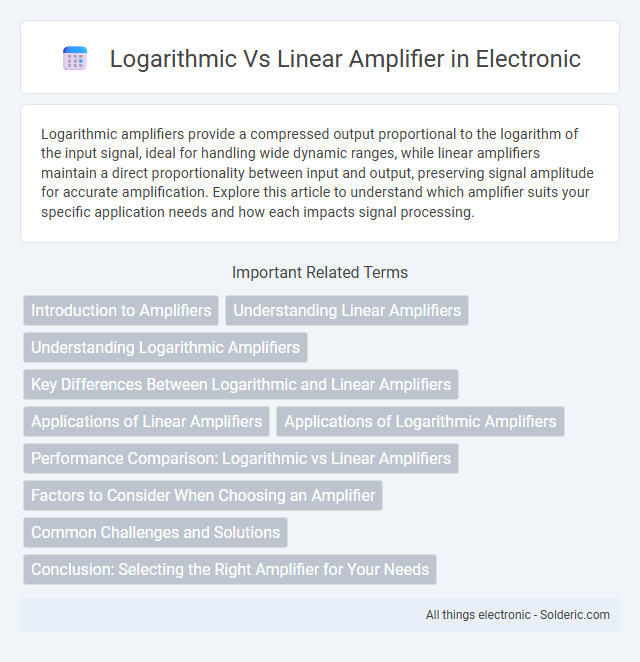Logarithmic amplifiers provide a compressed output proportional to the logarithm of the input signal, ideal for handling wide dynamic ranges, while linear amplifiers maintain a direct proportionality between input and output, preserving signal amplitude for accurate amplification. Explore this article to understand which amplifier suits your specific application needs and how each impacts signal processing.
Comparison Table
| Feature | Logarithmic Amplifier | Linear Amplifier |
|---|---|---|
| Output Relationship | Output voltage log(input voltage) | Output voltage input voltage (linear) |
| Dynamic Range | Wide dynamic range, handles signals varying over several decades | Narrow dynamic range, best for consistent signal levels |
| Application | Signal compression, RF power measurement, audio level detection | Audio amplification, sensor signal conditioning, general amplification |
| Accuracy | Lower accuracy due to log conversion non-linearity | High accuracy with linear input-output relationship |
| Complexity | Higher design complexity with non-linear devices (e.g., diodes, transistors) | Simpler design using linear components |
| Output Signal Type | Logarithmically scaled output voltage | Proportional amplified output voltage |
| Noise Sensitivity | Less sensitive to input noise at low signal levels | More sensitive to noise across signal levels |
Introduction to Amplifiers
Amplifiers are essential electronic devices that increase the power, voltage, or current of signals for various applications. Linear amplifiers provide a proportional output signal to the input, preserving waveform integrity and enabling accurate signal reproduction. Logarithmic amplifiers output a signal proportional to the logarithm of the input, allowing for wide dynamic range measurement and signal compression in applications like RF power detection and audio processing.
Understanding Linear Amplifiers
Linear amplifiers provide a constant gain regardless of the input signal amplitude, making them ideal for applications requiring accurate signal reproduction and minimal distortion. These amplifiers maintain signal integrity by amplifying both small and large signals proportionally, ensuring your output remains a faithful representation of the input waveform. Understanding linear amplifiers is essential for designing systems needing precise amplification, such as audio equipment, communication devices, and instrumentation.
Understanding Logarithmic Amplifiers
Logarithmic amplifiers provide output signals proportional to the logarithm of the input voltage, enabling accurate measurement of signals spanning several orders of magnitude. They are essential in applications requiring wide dynamic range detection, such as RF signal strength metering and audio level compression. This contrasts with linear amplifiers, which maintain a constant gain across the input range but struggle with large variations in signal amplitude.
Key Differences Between Logarithmic and Linear Amplifiers
Logarithmic amplifiers provide output proportional to the logarithm of the input signal, enabling a wide dynamic range and precise measurement of varying signal strengths, typically used in RF and sensor applications. Linear amplifiers maintain a constant gain, amplifying the input signal linearly with high fidelity, ideal for audio and communication systems requiring minimal distortion. Key differences include dynamic range handling, output proportionality, and suitable applications, with logarithmic amplifiers excelling in signal compression and linear amplifiers in signal integrity.
Applications of Linear Amplifiers
Linear amplifiers excel in applications requiring faithful signal reproduction with minimal distortion, such as audio amplification, instrumentation, and communication systems. Your audio devices and measurement instruments benefit from their ability to maintain signal integrity across a wide frequency range and amplitude levels. These amplifiers are crucial in scenarios where signal linearity directly affects performance and accuracy.
Applications of Logarithmic Amplifiers
Logarithmic amplifiers are essential in applications requiring a wide dynamic range, such as signal compression, automatic gain control in communication systems, and radar signal processing. Their ability to convert exponential input signals into linear output voltages allows precise measurement of large amplitude variations, making them ideal for audio level detection and spectrum analyzers. These amplifiers also enable accurate power measurements in RF circuits by providing a direct relationship between input signal magnitude and output voltage.
Performance Comparison: Logarithmic vs Linear Amplifiers
Logarithmic amplifiers excel in handling signals with wide dynamic ranges, offering precise amplitude measurements over varying input strengths. Linear amplifiers provide consistent gain and low distortion within limited signal ranges, ideal for applications requiring faithful signal amplification. Your choice between these amplifiers depends on the need for dynamic range flexibility versus linearity and signal fidelity in performance.
Factors to Consider When Choosing an Amplifier
Selecting between logarithmic and linear amplifiers depends on application-specific factors such as signal dynamic range, accuracy requirements, and distortion tolerance. Logarithmic amplifiers excel in handling wide dynamic ranges with compressed output but may introduce higher distortion and limited linearity, making them ideal for RF and sensor signal processing. Linear amplifiers provide high fidelity and low distortion output suitable for audio and instrumentation but require more complex gain control when dealing with large signal variations.
Common Challenges and Solutions
Logarithmic amplifiers often face challenges with distortion at low signal levels and limited dynamic range, while linear amplifiers struggle with noise performance and gain accuracy. Solutions for logarithmic amplifiers include implementing temperature compensation and advanced linearization techniques, whereas linear amplifiers benefit from feedback mechanisms and precision components to enhance stability. Your choice depends on balancing these trade-offs according to signal requirements and application constraints.
Conclusion: Selecting the Right Amplifier for Your Needs
Choosing between a logarithmic and linear amplifier depends on the specific application requirements, with logarithmic amplifiers excelling in handling wide dynamic ranges and accurate signal measurements at varying power levels. Linear amplifiers are ideal for applications demanding consistent gain and signal fidelity, such as audio processing or RF transmission with stable amplitude. Your decision should prioritize the nature of the input signals and the desired output performance to ensure optimal amplifier selection.
Logarithmic vs Linear amplifier Infographic

 solderic.com
solderic.com